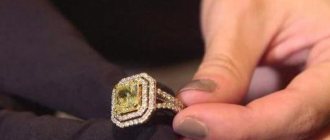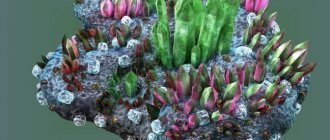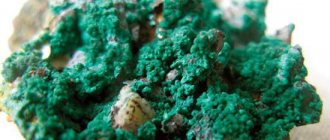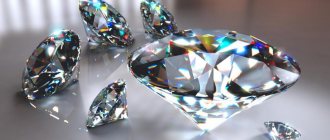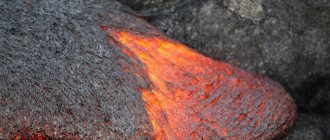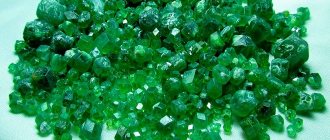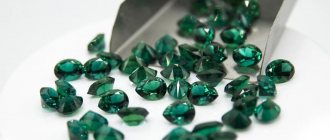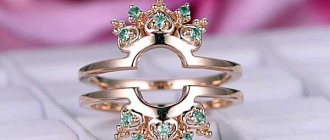Characteristics of the stone
Diamonds are considered the hardest stones in the world. On the Mohs scale, this indicator is 10 points. In addition, these minerals are the most expensive and transparent. A blue diamond when cut reflects light, shines brightly and is characterized by a play of color shades.
Due to the fact that blue diamonds are rare in nature, and the demand for them is constantly increasing, they began to be grown in laboratory conditions. Artificial minerals do not differ in properties from natural ones and look just as beautiful. But they cost significantly less.
It is impossible to distinguish the analogue from the original on your own.
A really expensive copy - “Blue Moon”
A blue diamond ring is much more expensive compared to its counterparts. Other jewelry is no exception, as are blue diamonds and diamonds themselves, which are intended to be purchased by wealthy people.
Now let’s try to imagine the scale of the pricing policy. There is, for example, a sub-item regarding the Blue Moon diamond that deserves special attention.
This stone is classified as “absolutely flawless” and, due to its rarity and uniqueness, was sold just seven minutes after the start of the famous Sotheby’s auction. Its fabulous price was $48,000,000. A new record was set for the sale of diamonds and other precious stones and jewelry directly at auction.
Previously, the record price for a precious diamond belonged to a diamond bearing the proud name “Graff Pink” or “Pink Earl” weighing 24.78 carats, which was auctioned at the same above-mentioned auction for 46,200,000 US dollars.
The new owner of the diamond miracle was a Hong Kong private collector, who exercised his right and immediately renamed it “Blue Moon of Josephine.”
A little about the background of the appearance of the gemstone
A blue diamond was found in the first month of the new year 2014, again in the well-known diamond miner - South Africa, in the aforementioned Cullinan mine. At that time it weighed 29.64 carats. It was immediately put up for auction, where the famous woman purchased it.
The master spent more than six months cutting, polishing and polishing the stone, not even then knowing that he was processing the most expensive bright blue diamond property. He decided to make a rather non-standard cut - cushion.
Even the specialists of the gemological center, during their assessment, did not reveal any inclusions or even hidden defects in it when examined under a microscope with tenfold magnification.
Smithsonian scientists from the famous institution once took the Blue Moon to study the unique physical properties that boron gave it. A blue diamond, like a diamond, always did not have an exact value; its price became known only at auctions. The people who participated in them were ready to pay several, and sometimes tens or hundreds of times more than the original price for such a diamond.
Possible shades
The shade of minerals varies. The color varies from pale, light to deep dark. Bright blue stones are especially prized. In nature they are extremely rare. There are also diamonds with the following shades:
- gray;
- black;
- purple;
- green.
Depending on the tone, gems are divided into the following categories:
- slight tint, almost unnoticeable;
- very light;
- average tone intensity;
- deep shade;
- dark colors;
- the brightest.
In addition, if the mineral contains nitrogen in addition to boron, it acquires an unusual tint of yellow color. More often, weakly colored stones and gems with admixtures of other shades are found. Intense, bright blue diamonds are much less commonly discovered.
Blue diamond and its shades
Diamond is a mineral characterized by absolute transparency. Blue specimens have a greater ability to reflect color than other varieties. The stones shimmer in different colors in the sun.
The darker the blue mineral, the more expensive its cost. Depending on the saturation of the shade, blue minerals are divided into types:
- Faint;
- Veri Light;
- Light;
- Fancy Light;
- Fancy;
- Fancy Intent;
- Fancy Vivid;
- Fancy Deep.
The blue tint of light crystals is noticeable only in the sun. The color of darker crystals is visible even in a dark room. Cut diamonds have the inherent ability to reflect and refract light.
In the sun, in addition to the blue tint, the stone shimmers with red, purple and yellow tones.
View this post on Instagram
Posted by otlichnyyden (@otlichnyyden) Apr 25, 2021 at 9:21 am PDT
Unique specimens
Among the most famous blue minerals are the following:
- Empress;
- Blue Emma;
- Eye of the Idol;
- Wittelsbach;
- Hope Diamond (also known as French blue, blue hope and blue devil);
- Josephine's blue moon.
Every blue diamond is shrouded in legends. For example, the owner of Blue Emma lived during the Second World War. The mineral saved the life of its owner more than once and was named after her. Emma repeatedly hid the stone in her mouth. The woman even had to swallow it.
She ended up in the Auschwitz camp, where she was left to die, but the woman survived. Emma attributed her poor health to the fact that the mineral was stuck in the intestines. The precious gem was later removed by surgeons during an operation to remove appendicitis. This blue diamond was sold at auction. Its cost was 6 million dollars.
The history of the Hope Diamond is no less interesting. The mineral, with its deep sapphire blue hue, was believed to bring trouble to its owner. It was named after the first owner, Henry Philip Hope. According to legend, this stone was removed from the crown of the French king and was then re-cut. The last owner of the gem was Harry Winston. He donated the gem to an institute located in the United States.
The history of the Wittelsbach mineral begins in the 18th century. It is named after the family to which it belonged. Its distinctive feature, in addition to its unique color, is its large size (35.56 carats). It was purchased by a jeweler named Graff. He paid more than 24 million dollars for the blue gem.
Josephine's Blue Moon stone was discovered in South Africa relatively recently (in 2014). No defects are visible on it even at tenfold magnification. The blue color surprisingly borders on purity and transparency. The diamond was sold at auction for more than $48 million. It received its name in honor of its owner's daughter.
One of the largest specimens is considered to be the Eye of the Idol.
Its weight is 70.2 carats and its cost is estimated at 375 thousand dollars. Its last owner was a jeweler who also bought the Wittelsbach stone. This flat, pear-shaped mineral was found in India. However, according to another version, the gem was discovered on the territory of Libya. There it was installed in the eye of one of the idols.
Deposits of unique treasure
Blue diamond is an expensive and rare stone. There are only 2 undepleted deposits with such crystals in the whole world. And even in them only a few large specimens are mined per year.
Deposits of blue diamonds:
- South African Republic, Cullinan field;
- Australia, Argyle field.
The first deposit of blue diamonds was discovered in the 17th century in India. Indians treated rare stones with almost fanatical reverence.
But Indians were in no hurry to purchase jewelry for their collections. They believed that they were cursed by the god Rama, and inserted diamonds into the eye sockets of his idols to avoid the wrath of higher powers. The mineral was also mined for export.
The largest and most famous crystals were mined in Indian mines. At the moment the deposit is completely depleted.
In nature, stones are found in the form of large and small blocks. Even in their raw form they are absolutely transparent. After treatment, their ability to reflect light is significantly enhanced. Therefore, crystals from the mines are immediately sent to jewelers.
The larger the diamond, the higher its value. Therefore, the jeweler’s task when cutting is to preserve the maximum possible size of the jewelry.
It takes jewelers several months to cut some diamonds.
In addition, see the story about rare stones:
Magic and astrology
Diamond jewelry can be beneficial. This is a powerful amulet that has the following effects:
- allows you to think soberly and make the right decision even in the most difficult situations;
- gives longevity;
- enhances power qualities;
- improves health.
True, the mineral does not always bring benefits. If a stone is obtained illegally, then it will only harm the owner.
According to the horoscope, blue gems are suitable for everyone except Scorpios. Maximum compatibility is noted with the following zodiac signs:
- Aries;
- Libra;
- Sagittarius;
- Capricorns.
Masterpiece of nature
A blue diamond, the color of which was formed under natural conditions, is valued much higher than artificially created or refined (regional) stones. After cutting, the resulting diamond becomes doubly beautiful. This is because they have a transparent structure, and the edges absorb the sun's rays and reflect colored highlights.
In nature, colored diamonds are produced due to various impurities. The blue or blue color (there is also a lot of interesting information in the article “Blue Diamonds”) is formed due to boron atoms, which are contained in the crystal lattice. They make up for the lack of carbon in the structure. The process of forming a colored stone takes several hundreds, thousands, and sometimes millions of years. If there are few boron particles, the color is light blue; if there are many, then it is bright and saturated. In a faceted stone, these characteristics are doubled.
Blue diamonds are evaluated according to several parameters:
- the presence or absence of defects and inclusions in the stone (purity);
- size and weight (measured in carats);
- stone deposit;
- color saturation (from light to dark);
- cut quality.
The cut comes in several varieties. The simple one is “rose”. With this cut, the stone loses minimal weight because fewer facets are made. The heart shape is a complex cut and it loses a significant amount of the diamond. Usually, simple types of cutting are used for rare gems. This allows you to preserve the maximum weight of the unique find.
Blue precious diamonds are prized among jewelers and collectors even in their raw, original form.
Interesting Facts
In India in the 17th century, the blue mineral was considered the eye of the god Rama. People believed that the gem brought numerous sufferings and misfortunes to the owner. Despite this, he was revered, because he was considered one of the stones of the gods.
The Hope Diamond is shrouded in mysticism. According to legend, all its owners died under mysterious circumstances. For example, when he got to France, a plague epidemic began there.
The owners of the mineral were also a family that traveled on the Titanic and died after the ship collided with an iceberg. The last victim of this mineral was the messenger who took it to the Washington Institute. The man fell under the wheels of a truck.
There are very few blue diamonds in the world. They attract the attention of collectors, jewelers and ordinary people, because this mineral is not characterized by such an unusual color. In addition, many unexplained events are associated with blue stones, so they always remain in the spotlight.
"Blue Emma" or an exciting story
Let's also take a look at another stunning diamond specimen that has saved a man's life on several occasions. Consider a sub-item such as the Blue Emma diamond, which has an interesting and unusual story told by a forensic medical expert.
One day, an intelligent woman with pain in the abdominal area came to their clinic (or rather, she was brought in an ambulance). Her name was Emma Aaronovna Zingelshmuller. In her appearance, one should note a tattoo in the form of a sequence of numbers, which recalled that evil and inhumane time when she was in German gas camps and miraculously remained alive.
After questioning, it turned out that most likely she had a suspicion of appendicitis. Therefore, they did not delay and decided to operate immediately. During the operation, some dense piece was found in the gastrointestinal tract, which, for all objective reasons, was the cause of suffering. The surgeon did not throw away the solid formation, but decided to examine it.
It turned out that it was a stone, which, as it turned out later, turned out to be precious.
The rescued woman decided to tell her story.
Rescue at the beginning of the war
If we omit all the little things, then the woman got the blue crystal from her ancestors and was passed down in the family from generation to generation.
Suddenly, World War II began. Being at that time in Minsk, which the Germans reached in two weeks, the lady miraculously escaped death the first time when she was a little late, taking the stone for herself upon returning home. Her mother, also Jewish by origin, did not recognize her when she was taken out of the house.
After this, Emma decided to go away from everyone and hide. At that time, collective farmers were not given documents, so the woman settled on a small farm, where a Belarusian woman took her in and passed her off as her niece. But nothing lasts forever, a new workforce was needed and she, like many others, was taken near the city of Guntersblue, where Emma met her former classmate, who a little later pawned her Jewish friend.
Diamond on the cheek
In 1944, before winter, officers from the formidable SS came for Emma and took her to the world-famous Auschwitz camp. Many would have already died, but not Emma, who turned out to be physically strong. The camp was living out its last days and all prisoners of the camp who were able to move were sent deep into the rear.
Later this event was called a “death march”. Just a few days before, Emma fell ill and was not taken, but left to die in the camp, thereby the blue diamond saved her life again.
After the war
After liberation, brave soldiers noticed Emma’s beauty and helped her find herself in post-siege Leningrad, which was returning to life. So she ended up in this hospital with her “stone” disease.
The blue diamond, as it turned out later, was practically always with her in the Auschwitz camp; she kept it behind her cheek, since otherwise it was impossible to hide it anywhere. Sometimes she swallowed it.
Here is an unusual and interesting story that shows how the Blue Emma diamond lived with its owner and saved his life several times.
But that is not all! Some time later, at a Sotheby's auction, a blue diamond of rare beauty was presented, which was bought by an Indian with several businesses in the scrap metal industry for $6 million. This diamond was called “Blue Emma”. His signature indicated that this sample was in the possession of an old Jewish family, which included jewelry makers. It also reported on the dramatic history of the stone.
Other popular diamonds
The largest and most famous gems, blue diamonds, are found in museums or owned by private collectors and jewelers. These people give everyone the opportunity to look at the stones for a fee.
List of the most famous blue diamonds:
- "Hope". Weighing 45.52 carats, the stone is one of the largest diamonds. It was found in the lands of India and was engraved from a diamond of as much as 112 carats. There were many different legends around the “Hope” diamond and most people were completely sure that it brought misfortune. Back in 1958, the stone was transferred to the famous American Museum of Art called the Smithonian, located in Washington. It was from that time that it was available for public viewing along with other precious diamonds.
- Diamond Tereshchenko. The original history of the unique 42.92-carat pear-shaped diamond is unknown. Only a few facts were found out - first it was acquired by a rich family from Russia, which owned sugar factories, in 1916 it was sold to Paris, and the last time people saw the diamond was at an auction in Geneva in 1984. A Lebanese merchant named Robert Mouwad bought the stone from the auction, after which he renamed the diamond “Blue Mouwad.” According to collectors and jewelers, the value of the stone is about $20 million.
- "Wittelsbach". The diamond with a royal history features 35.56 carats. It received its name back in 1722. It was then named after the Bavarian Royal Court of Wittelsbach. Its further fate was not known until the twentieth century, when it was acquired by Joseph Kommer, a diamond expert originally from Belgium. Joseph organized the sale of the stone and it remained in private hands until the mid-60s. It was only in 2008 that the diamond was resold to one influential international jeweler, Laurence Graff. At that time, the cost of the Wittelsbach stone was exactly 24.3 million dollars.
- "Sultan of Morocco". The history of the 35.27-carat Sultan of Morocco diamond begins in the 19th century. In 1840, it was purchased by Prince Nikolai Borisovich Yusupov, who was a member of a noble Russian family. He bought it in Europe. The stone remained in the possession of the Yusupov family for 82 years. In 1922, it was purchased from Prince Felix Yusupov by the New York jewelry house. Already in 1972, the stone was sold for the last time to a private collector. It is he who still has the diamond to this day.
- "Blue Hedgehog" (or "Blue Heart"). A rather bright blue stone of 30.82 carats, according to one legend, belonged to the Empress Jerzy herself, who was the beloved woman and also the wife of Napoleon III. Many experts do not entirely believe this legend, but today it is considered one of the main ones. Experts have found out for sure that the diamond began to have such an unusual engraving in 1909 in the capital of France. There it was shaped into a heart by local jeweler Atanik Ikiyanan. Immediately after this, the stone was bought by an American jewelry house, and later it was handed over to Mrs. Ung, who lived in Argentina. This woman kept it until the mid-twentieth century, and then was sold to another jewelry house, which resold it to a European family. The deal was concluded for 300 thousand dollars. A little later, Harry Winston acquired the diamond. As a result, “Blue Heart” ended up in the Smithsonian American Museum of Art. Today, the diamond remains there as an exhibit of a precious collection that can be admired by locals and tourists.
Knowing the beauty of blue diamonds and their value, there is no doubt about their naturalness. The above stones appeal not only to experienced collectors and jewelers, but also to ordinary people who prefer to wear jewelry with them.
Exclusive products with colored diamonds. View catalog >>>
— 0.68ct Fancy Light Blue Radiant cut diamond with a GIA Internally Flawless clarity.
A gem stone for lovers of blue diamonds. Sert. GIA - 1.04 ct. Fancy Green-Blue VS2. A rare combination of green and blue colors in a lovely stone with high clarity set in bed of fine Argyle diamonds. Sert. GIA.
View all blue diamonds for sale.
Natural blue diamonds are among the rarest of the rare natural fancy diamonds, and their popularity has skyrocketed in recent years. Blue diamonds are extremely rare in nature, with only one in every 10,000 diamonds being blue. The rarity of natural blue diamonds explains why most jewelers have never seen and will never see these stones. The rarity of blue diamonds, their extraordinary beauty and, as a consequence, high price have led to the fact that these stones are considered the privilege of the elite. Blue diamonds deservedly have the reputation of elite precious stones. Naturally, we are talking about natural fancy blue diamonds, and not about an artificially obtained color.
